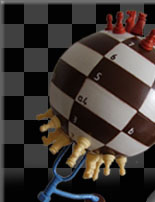 |
| The game uses annular
ranks and limited files. The pieces cannot step to
the X and Y polar squares, neither can they pass over these
squares (64
squares are used).
In this version the lower and upper edge of the chessboard
remains on the outer edge of the first and the eighth annular
rank (around squares X and Y, similarly to the so – called cylinder
chess), but the traditional corner squares disappear.
Vertical movement of the pieces along the files is restricted
(they cannot pass over squares X and Y). As the pieces move
on the files from central squares to the polar squares, their
power is gradually reduced (similarly to classic chess).
On the other hand, there are no edges and corners on the
annular ranks, which means, that the power of the pieces
is greatly enhanced along ranks and diagonals. The opponent’s
pieces can be attacked from any direction – meaning from
left and from right around the sphere.
|
|
|
The rook (figure nr. 1)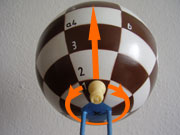
Along the files the rook can move between the polar squares (Ra1-a2,
a3, a4, a5, a6, a7, a8). Along the ranks the rook can either
move around the sphere in the direction Ra1 – b1, c1, d1, e1,
f1, g1, h1 or backwards (Ra1 – h1, g1, f1, e1, d1, c1, b1). Attention!
7 squares can be attacked from two directions.
In contrast to the classic chessboard a given square can be reached
from two directions on the chess – sphere. In our case the Rook
on a1 can reach the opposite square e1) using two ways, to the
right (Ra1 – b1 – e1) and to the left (Ra1 – h1 – e1). The base
rank, as well as other ranks behave as endless rings on the sphere.
In the practice the path of a rook on the first rank can be obstructed
by the player’s own or the opponent’s pieces, but the rook still
has the option to use the opposite direction, where the squares
are unoccupied. This way its effect is greatly increased.
|
The bishop (figure nr. 2)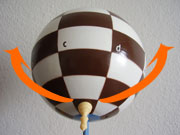
The bishop moves on the diagonals, using only squares of a given
color. Compared to the classic game its value has increased,
because it can pass over the invisible boundary between the
a) and h) file (the original shorter diagonals disappeared).
The path of the bishop from c1 to the right leads through these
squares: Bc1-d2, e3, f4, g5, h6, a7, b8. This way the bishop
doesn’t step on the Y square.
The second possibility is to use the other diagonal (to the left):
Bc1-b2,a3, h4, g5, f6, e7, d8. The Y square hasn’t been used.
The two routes meet on the g5 square, where they cross each other
in a 90° angle. Thus, this square can be reached from
two directions. In case one of them is closed down by own or opponent’s pieces,
there is still the option to use the other diagonal for attack
or defense.
|
The queen (figure nr. 3)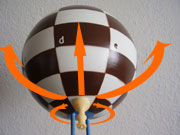
The queen can move on the sphere like the bishop and the rook combined. From the first rank it exerts its influence over
14 squares (7 in each direction) if it moves like a rook, but
the queen can reach 13 additional squares moving like a bishop.
This way the queen is the piece with the greatest power. The
movement of the queen as a bishop and as a rook cannot
cross each other in the simple version of Globe – chess (e. g. Qd1). |
The knight (figure nr. 4)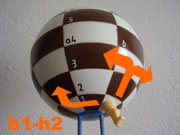
The knight on b1) can reach the following four squares: a3, c3,
h2, d2. The power of the knight has also increased on the chess
– sphere, because on the classic board it couldn’t reach h2.
The knight can horizontally travel around the chess – sphere
in four L – shaped moves, e. g. Nb1 – d2 – f1 – h2 – b1, coming
back to its original position. If the knight is positioned
on the crossing point of the diagonals used by queen and bishops,
its movement and attacking potential is greatly increased compared
to its usual power (with the protection in two directions). |
The king (figure nr.
5)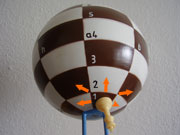
The king can move one square in any direction, including movement
from the a) to the h) file (and back), e. g. Ka1 – h1, Kh2
– a3. Along the ranks the king can travel around the chess
– sphere.
|
Castling (figure nr. 6)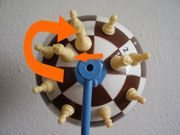 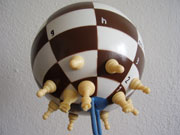
Due to the structure of endless ranks a new possibility emerges
for the king to be protected by the annular protection of the
rooks. This is a new way of castling on the chess – sphere, the
rooks protect the king from two directions. On a single annular
rank the king is protected by two rooks, each using two directions
in their movement. |
The
pawn (figure nr. 7)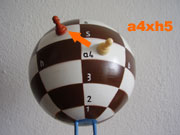
The pawn can capture from the a) file to the h) file and back,
because the board has no horizontal edges. If the pawn reaches
the last rank, it is promoted to a chosen piece of the same color
(except for the king).
Summary:
The game requires a certain amount of practice, greater knowledge
and concentration, because the player sees only half of the
„board“ (which is compensated by the new capabilities of the
pieces and new variations of the game), although all the squares
are under control if the sphere is rotated. The gameflow becomes
easier by the study and utilization of typical patterns and
situations. The simple version of Globe – chess provides means
to explore new, uncharted territories, to understand them,
to solve more demanding problems and to realize the beauty
of the game.
|
|
|
|
